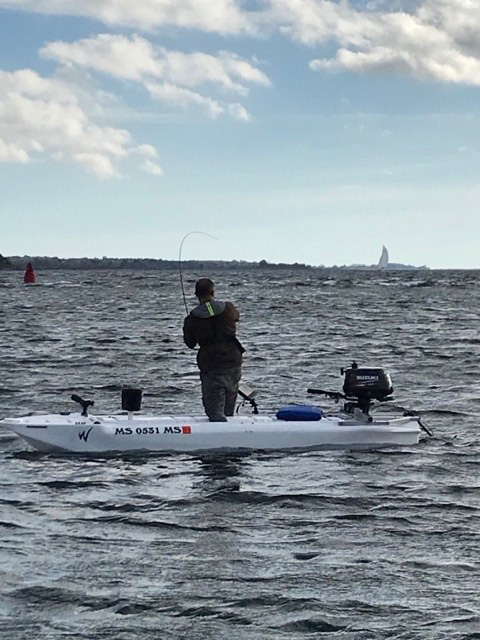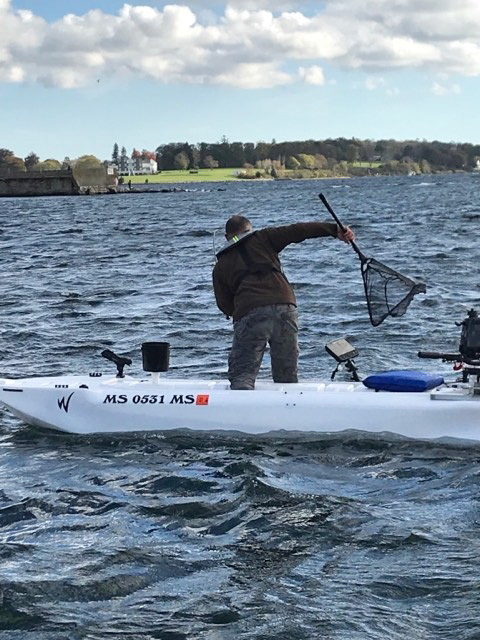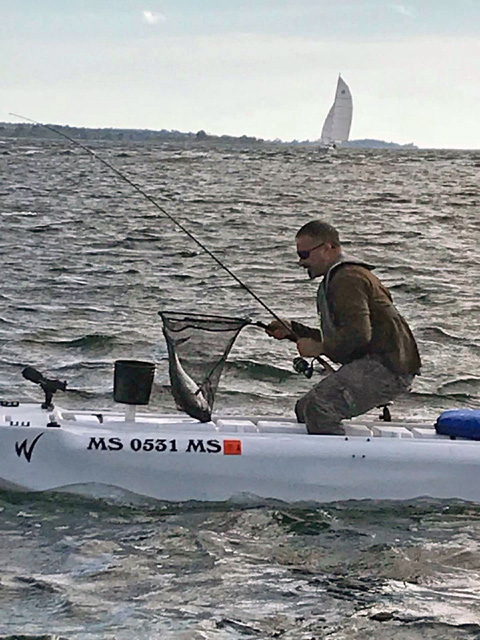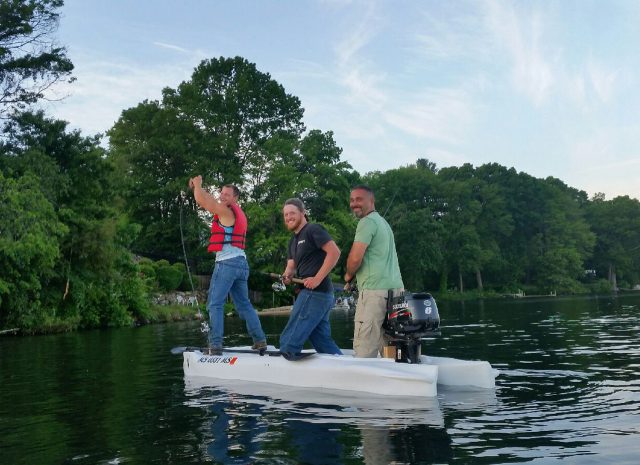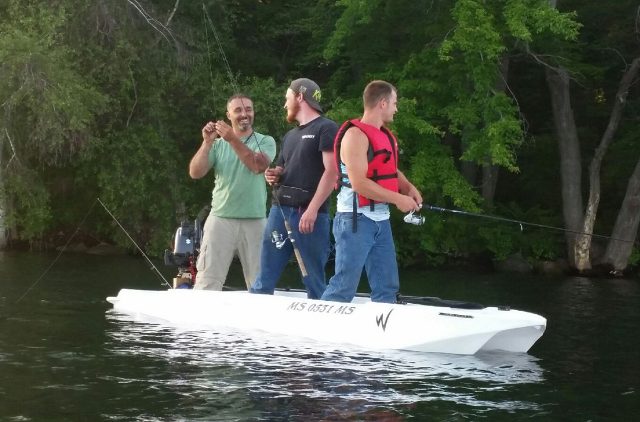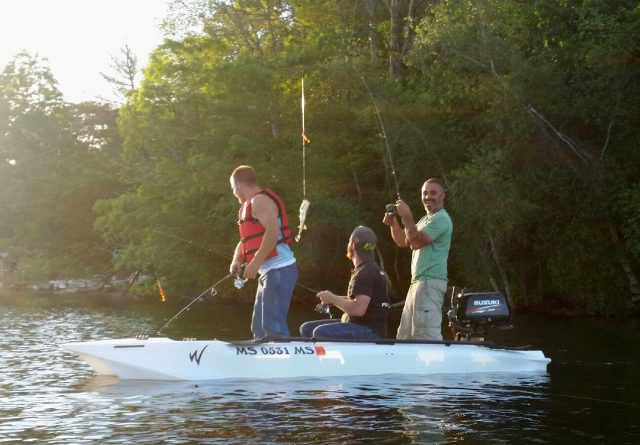TRUE STAND UP FISHING KAYAKS
What makes stand up fishing and paddling a good experience in the real world, and why it matters to you
This article examines what makes stand up fishing so important, and why an increasing number of kayak fishermen are disappointed by the common SOT and sit-in kayak designs that fail to deliver adequate stability, comfort and safety. These anglers end up standing and fishing in a Wavewalk 500 Kayak, often despite potentially problematic factors such as their old age, large body size, and various physical disabilities. More demanding anglers go for the bigger Wavewalk 700, which allows two anglers to fish standing in full comfort, and anglers who need a fishing kayak that performs better than many boats, fish standing in a Wavewalk S4, the world’s most stable kayak.
Kayak fishing for Albacore standing in a Wavewalk S4
Click images to enlarge
Three big guys fishing standing in the new Wavewalk S4 –
Click images to enlarge. Read the full story »
Driving standing in a Wavewalk S4 powered by a 9.8 HP outboard motor, in the ocean, full throttle? –
Before going further, please watch this W720 video that shows what we call ‘boat stability’:
The above video shows that the stability offered by the W720 is comparable to the stability offered by boats such as Jon-boats and dinghies, namely that although the W720 paddles better than any fishing kayak or canoe out there, it is no longer a kayak when stability is concerned – For this matter, it is comparable to a boat.
CONTENT
- Fishing from small watercraft – Overview
- What about stand up fishing from sit-on-top (SOT) kayaks?
- Why is standing in your fishing kayak important?
- Stand up fishing kayak demo movies
- Are other kayaks safe enough for stand up fishing and paddling?
- What about very wide SOT kayaks?
- And what about SOT kayaks with outriggers? (stabilizers)
- Differences between kayaks for stand up paddling and stand up fishing
- What happens when you catch a fish standing up in a kayak?
- Stand up fishing kayak pictures, and what they mean to you
1. Fishing from small watercraft – Overview
People all around the world have been fishing from small boats for millennia. Interestingly, many native fishermen like to stand up in their boats when they propel them and fish from them. After all, what could be more natural? If possible, standing is both a powerful and comfortable position for a person making a continuous physical effort. It is good for our blood circulation, less strenuous on our back and it enables us to make a good use of our legs, which happen to have the most powerful set of muscles in our body.
It is worth noting that wade fishermen, people who fish from shore and people who fish from bigger boats also like to fish standing, if not all the time at least for a great part of the time. Standing makes is easy to cast a line or throw a net, and certainly makes it easier to scout for fish and better stops to fish in.
When the native people of the arctic circle developed their kayaks the L position was natural to them and they were not particularly concerned with comfort but rather with stealth, as their kayaks were designed mainly as hunting boats enabling the hunter to get close to its prey without getting noticed. However, when these people went fishing or whaling they usually preferred to use Umiaks – a type of big, wide and stable multi-passenger seaworthy canoe that offered them the possibility to stand up.
Casting a fishing or a shrimping net standing in a boat requires more stability than angling does. Read the article »
2. What about stand up fishing from sit-on-top (SOT) kayaks?
Stand up kayak fishing sounds like an oxymoron since most people find it difficult enough to sit it inside or on top of a kayak, especially when it involves fishing.
Some fishing kayak manufactures advertise that their most stable models may enable a person to stand in or on top and cast but there is no real proof to support such claims. At best, those very wide SOT kayaks may enable a child or a very small and lightweight adult to stand on but certainly not with enough confidence to enable casting and landing fish. No traditional SIK or SOT kayak manufacturer ever claimed they offer a kayak that may enable a person to paddle standing…
The reality with regards to traditional SIK and more recent SOT kayaks is that these small and lightweight crafts offer good mobility at a low price and for a low cost of maintenance, but at a price of diminished comfort and the inability to do anything standing up.
3. Why is standing in your fishing kayak important?
Besides the fact that standing up improves your chances of catching fish there’s a more important fact related to it: Your ability to stand up goes directly to your comfort and well being, and to your overall fishing experience. After all, catching fish is fun but not as much when it comes at a price of unnecessary fatigue, serious physical discomfort and even pain resulting from being limited to a single, uncomfortable sitting position, without being able to do anything to change positions and relieve pressure on your lower back.
When fishing comfort is key to both success and fun, and neither leg numbness nor back pain may contribute to either although you’re most likely to experience at least one of them after sitting for a while in the traditional kayaking position. And don’t let yourself develop hopes in ‘improved kayak seats’…- Adding some cushioning and changing the shape of the seat can’t change the basic physiological facts: You’re stuck in a sitting position to which you’re not used, and your legs are pushing you backwards and creating a pressure point in your lower back.
Even today, most fishing boats are big and stable enough to enable their passengers to stand up while fishing. So why shouldn’t you stand up in your small, inexpensive and portable fishing kayak? The patented Wavewalk twin-hull fishing kayaks offer you to do that, as well as many other things without giving up any of the regular fishing kayak advantages. In fact, when it comes to the known advantages of fishing kayaks over bigger fishing boats, even the small the Wavewalk 500 Kayak offers you some real, additional advantages such as better protection against wind, spray and waves, better mobility when it comes to ease of launching and take-out, better handling of the surf, better tracking, more dry storage space, and overall a much higher level of seaworthiness.
Kayak fishing may be a sport, but since you’re doing it for fun you may as well have fun doing it. Kayak fishing is a good idea if indeed it’s done properly, that is without reducing your fishing experience. Wavewalk kayaks can unleash the full potential of kayak fishing and upgrade it to what it’s really meant to be: a challenging, full sport activity that you can practice without constantly thinking of the comfort that bigger fishing boats have to offer.
Wavewalk kayaks are the only kayaks that offer high performance stand up paddling and stand up fishing in moving water, and they are the only kayaks that fit both these extreme applications in terms of safety and comfort.
Here are the facts we recommend you know about stand up padding and fishing from kayaks and other small craft –
4. Demo movies
This demo movies is extreme, but it shows what stability you actually need to get from a kayak when you’re out there in the real world, where stuff happens is the rule, and not a rare exception. Note tat these two videos show the small, now discontinued W500:
We call this performance of the Wavewalk 500 kayak “Super Stability”. Wavewalk has replaced the small W500 with the bigger and stabler W720 and S4.
The newer and bigger Wavewalk 720 is more stable than the W500 was, and the stability is offers is comparable to the stability that one experiences in a Jon boat or a skiff. We call it ‘Boat Stability’.
The Wavewalk S4 is the world’s most stable ‘kayak’ by far, even more stable then some boats, and it offers comfortable stand up paddling and fishing for three adults –
5. Are other kayaks safe enough for stand up fishing and paddling?
Since many things can and will cause you to lose balance if you choose to stand up in or on top of a kayak, you must be able to react effectively and regain balance even in adverse conditions, and our W-kayak enables you that while no other kayak does.
Our patented twin-hull Wavewalk® kayaks are the only kayaks that offers each of your legs to stand in a hull of its own, and they are the only kayaks created especially for stand up paddling and stand up fishing.
Sooner or later you will lose balance (stuff happens – you can be sure about that!), and for such cases you need to have a ‘Plan B’, which would be to fall down on something that’s high enough to stop your fall as well as support you.
You don’t want to fall all the way down on your kayak’s deck since it will cause you to fall overboard. You definitely don’t want to slip either, and therefore your feet must be secure where you stand.
The Wavewalk saddle seat has a hull on each of its sides. You ride it with each of your legs supported by its own hull, and your feet planted at the bottom, several inches below waterline. Being positioned that low is what makes your feet really effective for stabilization and control.
For these reasons you’ll never be truly confident or comfortable standing on top of any sit-on-top (SOT) kayak, even if staged pictures and movies may show you people standing on their SOT kayaks and fishing.
You must remember that neither sit-in nor SOT kayaks were invented for stand up paddling or fishing in the first place. Some people are capable of pedaling a unicycle while juggling oranges, and others can hop between wooden logs floating on a river. Does it mean you can do it? Would you even like to try?
-What’s the point in taking the risk of falling overboard anytime you go fishing? -Would you feel confident standing up on an unstable platform?
6. What about very wide SOT kayaks?
SOT kayaks with very wide hulls track poorly and are hard to paddle, and they may be stabler than narrow ones, but definitely not stable enough when it comes to paddling and fishing in confidence. This is because most of a SOT kayak’s buoyancy (that’s what actually supports your weight) is distributed along its hull’s center line, where it is useless for effective stabilization. If you want a kayak that’s stable you need one that has all its buoyancy distributed along its sides – exactly as it is in the Wavewalk twin-hull kayaks. In fact, the W-kayak has no buoyancy wasted along its center line, since 100% of its buoyancy is located on its two sides – as far as possible from the center line.
7. And what about SOT kayaks with outriggers? (stabilizers)
The use of outriggers, whether as add-ons or integrated into the hull can improve your kayak’s stability, but not enough for stand up paddling and fishing in full confidence, which is what you really need.
This is because kayak outriggers are located in the back part of your kayak’s hull, and therefore may support extra weight and pressure only if you apply them towards the back. Such outriggers are nothing more than a gimmick if you’re applying your weight forward and sideways, and you can be certain that when you’re standing up you’ll have to do that often.
Remember: stuff happens in real life, and water is always wet, and sometimes it can be cold, and deep.
Between attached and integrated outriggers the latter offer reduced stability because of the fact that their center of buoyancy isn’t located as far away from the kayak’s center line, where it would offer more support. It’s simply a bad idea when stability is concerned, and traditional outriggers offer a better support.
Furthermore, integrated outriggers coming out of the main hull form a Y shaped hull which is probably the most ineffective form ever created when it comes to paddling, or any other form of propulsion. In other words don’t count on such design for paddling.
8. Differences between kayaks for stand up paddling and stand up fishing
Both need to be extremely stable, but there are differences in requirements.
A stand up paddling kayak is required to be narrow as possible, since it makes it easier to move the paddle efficiently and ergonomically, as it is in regular (seated) paddling. A kayak that’s too wide would under perform in stand up paddling, as it would in seated paddling.
A stand up fishing kayak needs to be even more stable than a stand up paddling one because the paddle may help you balance yourself, while a fishing rod would be ineffective for this purpose. This is where the location of the kayak’s buoyancy becomes critical, as does the location of your legs and feet.
The Wavewalk® 500 is just 29″ wide, and yet, due to its revolutionary design that was granted a US utility patent, it is more stable than large-size SOT fishing kayaks.
This means that you’ll benefit from its unique features, while other kayaks simply don’t have such a broad performance envelope to begin with, and would never offer you anything that even comes close.
Again, we recommend the you watch our demo movies for a start, and judge for yourself.
9. What happens when you catch a fish standing up in a kayak?
After casting for some time you’ll probably hook up a fish. If that fish doesn’t manage to make you lose your balance and fall overboard you’d need to land it in or on top of your kayak… and then what? If getting up from the seated position and going back down to it is hard to begin with, how does it feel when you have sit down while holding a fishing rod in one hand or both hands, and there’s a good size fish dangling at the end of your line?
Obviously, this doesn’t make much sense, and it’s another example that shows how important it is to have something to fall back on easily and intuitively (a ‘Plan B’), which in this case means (again) safely and comfortably. This is where the Wavewalk saddle seat comes into action: It’s 15″ high, and it’s waiting for you to sit down and drop the fish in one of the hulls, where it has nowhere to go, and won’t cause you any problem. In comparison, other fishing kayaks feature a seat that’s as low as possible – practically at deck level, and nowhere to park the struggling fish except in your lap…
If you’re interested in learning more about kayak design for better stability, we recommend the following stability article ».
Never judge a kayak by stand up pictures or movies shot under regular conditions – It may look nice and cool but it’s meaningless for you since it doesn’t show performance in ‘what if’ conditions.
Many things can and will destabilize you, including fish, wind, eddies, waves, wind and your own, inevitable moments of inattention.
What you need to be able to judge is the ‘what if’ performance, and no other kayak compares to Wavewalk’s patented, super stable twin-hull kayaks.
This article would be incomplete without providing more information about what people who fish standing in their Wavewalk kayaks have to say about their real-life experience. Our website offers Wavewalk Fishing Kayak reviews contributed by such people, including full name and state, and in most cases pictures too.
ARTICLE: Motorized stand up fishing kayaks »
Electric trolling motors vs. gas outboard motors, transom mounts vs side mounts, offshore and inland – and more.
Do you have any questions for us?



